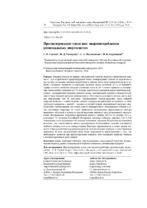Прогнозирование часов пик энергопотребления региональных энергосистем

Date
2024Publisher
Another Title
Forecasting Peak Hours for Energy Consumption in Regional Power Systems
Bibliographic entry
Прогнозирование часов пик энергопотребления региональных энергосистем = Forecasting Peak Hours for Energy Consumption in Regional Power Systems / С. Р. Саитов [и др.] // Известия высших учебных заведений и энергетических объединений СНГ. Энергетика. – 2024. – № 1. – С. 78-91.
Abstract
Вторым товаром на рынках электрической энергии является электрическая мощность. Для потребителей тарифицируемый объем «генераторной» мощности определяется как среднее из часовых объемов потребления в рабочие дни в часы пиковой нагрузки в регионе. Стоимость мощности в отдельных регионах может достигать 40 % от конечного тарифа, поэтому снижение нагрузки в пиковые часы на 10 % может привести к уменьшению ежемесячных платежей на 3 %. Однако такой способ экономии для потребителя недоступен – коммерческий оператор оптового рынка электрической энергии и мощности публикует часы пиковой нагрузки регионов после 10-го числа следующего месяца, когда данная информация уже не актуальна. Своевременное прогнозирование часов пиковой нагрузки позволит, с одной стороны, снизить издержки потребителей на платежах за электрическую мощность, с другой – сгладить суточный график электрической нагрузки энергосистемы, оптимизировав тем самым работу генерирующего оборудования станций и сетей системного оператора. В статье приводится исследование эффективности методов машинного обучения в контексте прогнозирования пикового часа региональной энергосистемы. Исследование затрагивает временной период с ноября 2011-го по октябрь 2023 г., охватывает 76 регионов Российской Федерации, включая субъекты ценовых (1-й и 2-й) и неценовых зон и насчитывает 10 методов машинного обучения. Результаты исследования показали, что статистически метод кластеризации K-ближайших соседей оказывается наиболее точным, хоть и не универсальным. Высокую эффективность (с точки зрения точности и быстродействия) продемонстрировали методы опорных векторов и классификация деревьями. В ходе исследований также было опровергнуто предположение о том, что наибольшую ценность при прогнозировании пикового часа оказывают наиболее близкие, с позиции временного ряда, данные.
Abstract in another language
Electrical power is the second most important commodity in electrical energy markets. For consumers, the charged amount of “generator” power is determined as the average value of hourly consumption amounts on working days during peak hours in the region. The cost of power in some regions can reach 40 % of the final tariff, so reducing the load during peak hours by 10 % can lead to a decrease in monthly consumer payments by 3 %. However, such a way of saving money is not available to the consumer since the commercial operator of the wholesale market of electricity and capacity publishes the peak hours of the regions after the 10th day of the next month, when this information is no longer relevant. Timely forecasting of peak hours will make it possible, on the one hand, to reduce consumer costs for payments for electric power, and on the other hand, to smooth out the daily schedule of electric load of the power system, thereby optimizing the operation of generating equipment of stations and networks of the system operator. The article presents a study of the effectiveness of machine learning methods in the context of forecasting the peak hour of a regional power system. The study concerns the period from November 2011 to October 2023, covers 76 regions of the Russian Federation, including subjects of price (1st and 2nd) and non-price zones and includes 10 machine-learning methods. The results of the study showed that statistically, the K-nearest neighbors clustering method turns out to be the most accurate, although not universal. Support Vector Classifier and Decision Tree Classifier have demonstrated high efficiency (in terms of accuracy and speed). The study also refuted the assumption that the closest data in terms of time series has the greatest value in predicting peak hours.
View/
Collections
- № 1[6]
